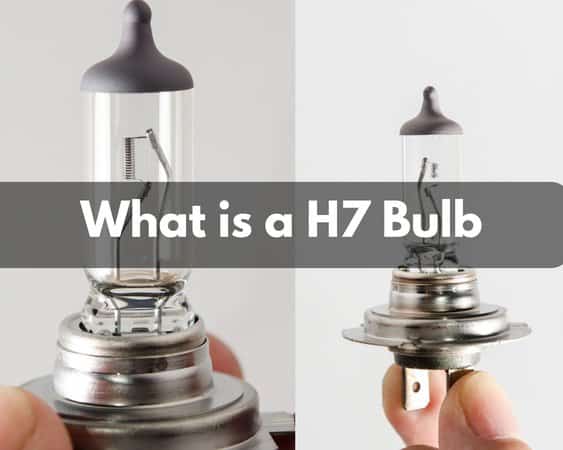Headlights or headlamps are a must addition to any vehicle; they are the way to illuminate and help the drivers see what’s in front of them and create a specific beam pattern that is adjusted to focus where it is needed.
And the drivers’ popular choice award goes to…H7 bulb! Well, why? Let’s find out.
H7 stands for halogen lamps and LED lamps, mainly used for automotive purposes.
Because of the mechanism that has been crafted with delicate intricacy and a scheme to produce to brighten up objects the narrower distance.
We’ll look more into this in the next section.
The reason behind the bulbs focusing only on narrow and short distances is the engineering behind it.
Also, keep in mind that these bulbs are not as efficient as LED ones, but as they are ubiquitous and don’t strap you off cash, they are more popular.
Are you interested to know the magic behind this bulb? Well, we are too!

How Does H7 Bulb Work?
Think of it as a short work process.
The headlight has a glass container (the bulb) that’s been filled up with halogen gas, a wire filament to conduct and induce electricity, and a glass cord to insulate and resist the extreme heat produced while the bulb runs.
When the headlights are on, electricity approaches the wire filament; it gets heated up and produces light.
The glass bulb is (obviously) used to increase the brightness amplitude, and the glass filament is there to contain the heat.
The bulb also has no ground wirings, so a basic two-pronged plug.
Three-pronged plugs aren’t allowed for H7 ones because that will change the non-interchangeable fitment feature of the bulb.
However, this is just the halogen version; LEDs don’t rely on filaments, hence the longevity increases, and the whiteness is also impressive.
H7 Headlight Bulb Fits What Cars
Before you start rushing to the store for H7 bulbs, it’s time for us to have the *headlight talk*.
So, there are headlights that can be differentiated in so many ways.
The primary two types are ones that are used for the more significant part (headlights and taillights, i.e., H7); and those used for the minutiae parts (daytime running lights).
The second differentiating factor can be the prong count (discussed before), followed by filament count (H7 is a single filament one), and lastly, the LED and halogen fight!
The good news is that H7 is available in both of these versions.
Halogens are commonly used, whereas LEDs are longer lasting.
Eventually, it all comes down to one thing, which is the price.
When you decide what type of bulb you want, well, it will be determined by your car.
But some vehicles that allow you to use the H7 bulb features are BMW, Mercedes, Audi.
But these are not the last; you can just ask the manufacturer.
But because they are so popular, your car may avail to have a universal fitment option so that you can fit the bulb easily.
Features of H7 Headlight Bulb
Now, let’s get to the exciting part, shall we?
01. Brightness
This is a feature we all seek when it comes to the safety and convenience of passengers, drivers, and pedestrians.
The average value is 1500 Lumens, which is the basic halogen brightness level.
But if you upgrade to newer technologies like xenon (which is also a halogen) or LED bulbs, you can expect 2300 Lumens as well.
02. Safety
Since they are so bright and sparkly, these are safe.
But also, the filaments are triggered for passing electricity; the bulb can shut off any time, which can turn out to be a drawback.
So more power is not always more light.
Instead, in this case, you have to be careful that the filaments don’t get to catch fire.
And again, higher wattage bulbs are not road legal!
03. Where/When Used
Tracing back to the previous point, these are for off-road use only.
They produce 50% or so more light compared to ordinary ones.
So, any exterior usage is prohibited for that. (Not E marked)
With the placement strategy, these H7 bulbs work best as headlights.
04. Power Consumption
The average value is 55 watts (Can go up to 90 watts).
And as for the voltage values, it draws 12 volts.
05. Efficiency
This is the point where things get a bit upsetting.
Because it produces so much heat, it eventually interprets the dismissal of energy in the wrong way.
The lifespan, as a mal by-product, gets decreased as well.
But if you cater to customary conditions for the bulbs and the cars, they can last up to 1000 hours.
06. Price
Without sugarcoating things, we will be frank with you.
H7 bulbs are a bit more expensive.
And it all comes down to the energy consumption method, which is a costly process to manufacture.
Then there are also these high digits for the brightness levels and power-so, all of which add up to the more prominent monetary figure.
You have to be ready to pay somewhat $70 to $100 for a set of H7 headlights, and maybe more if you go for the higher-end ones!
What is The Brightest H7 Headlight Bulb?
The list of brands that make H7 bulbs is pretty long, but the one that has won users’ hearts is the Philips Racing Vision GT200.
They are the brightest, having the right color and color temperature.
It also makes the most precise vision for drivers and passers-by in both categories.
Benefits of Using H7 Bulb
The bright yellow light is the first and foremost benefit of having an H7 bulb, as that doesn’t merge with the sparking daytime sunlight.
Here are some other brilliant features that will be a good aid.
01. It is bright but not strong enough to blind the drivers. They also follow along with the optimal wattage limit with off-road day running lights
02. The low beam tech also serves as another guidance in unfavorable weather conditions such as rain or fog and gives a clear vision of objects upfront
03. No matter the price, H7 bulbs are easy to install. And as you install when you switch on, it will be a matter of a few blinks to see them sparkle, contributing to less energy wastage
Last but not least, the H7 bulbs are suitable for a versatile range of car types starting from SUVs to sedans.
Common Problems of Using H7 Bulb
Even though there is much potential for these fantastic bulbs, some minor details can stretch the market demand value.
Here are some common problems that have been faced while using H7 bulbs as headlights.
a) First off, the efficiency was put in front of questions. We must remember that the bulbs generate light through heating filaments, and guess what? Filaments tend to burn out. This is linked with the heating issue of the filament
b) Not only that, but the battery life is also directly affected by this phenomenon, not to mention the short lifespan of its own
c) To add to the agony (?), these bulbs get dimmed and dull over time
Short snags, but altogether enough to put you down, eh?
Is H7 Bulb Better Than Other Types?
Well, they are pretty much all the same (They illuminate things!).
We guess it’s for us to present the data and for you to find out.
But before we judge them, let’s take a quick overview of what bulb means.
The factors that make a difference in their number of filaments (All are single filament except for H4), the power generated, and the type of base/mounting through which they are connected to the bulb sockets.
We’ll be comparing each with H7 as the central reference point based on some fixed factors.
Such as brightness, safety, where/when used, power consumption, efficiency, price, and finally, pros and cons.
The 6 Differences Between H1 Vs H7
- The first spotted difference is that H1 produces an emission result of a high beam, and H7 does the opposite.
- H7 is used for daily off-road uses, whereas the other is for occasional services on dark roads.
- H7 has a power of 1350 Lumens on an average rate, but the other has a higher value of 1410 Lumens.
- The efficiency is almost the same for both types of bulbs (wattages). But you can rely on the H1 ones to be on the lower side.
- H1 bulbs are cheaper than H7 ones.
- H1 and H7 have the same type of defaulter features as well. The filament tends to get heated up.
Differences and Similarities Between H4 Vs H7
01. H4 is a double filament bulb and a single base plate, but it’s not the same as the H7 one somewhat; the numbers get interchanged.
02. The light output is more outstanding in H7 headlight bulbs because there are some transmission inductions when two lamps get along, which is not the case for H4 bulbs.
03. When the accumulative price is considered, H7 again takes place because we need four of them to make the system work; in contrast, we need only two H4s.
The Basics of Differences Between H7 Vs H11
a) Firstly, you should note that H7 bulbs are used as low beam bulbs. Contrarily, the other sort is used as fog lights.
b) H11 bulbs have a long lifespan of a whopping 50000 hours, which is a better value than that of an H7 bulb.
c) H11 has a Lumen credit of 1250, and hence, H7 wins the competition!
Related Frequently Asked Questions
Well, well, we are towards the end. Just a snippety of what we think you might be thinking.
Will There Be Any Problems If I Swap and Upgrade The Bulbs With Higher Wattage?
The short answer is no. You can do the other way around (But who wants that anyway?).
But a sneaky trick to upgrade your car this way can cause serious downgrading instead!
Can I Use H7 Bulbs From Any Brand Available?
Higher-end brands are always reliable and recommended, but if you are talking about fitments and stuff, then yes, you can almost fit any brand into any car that has been approved to take in an H7.
I Have Bought an Upscale Brand Set of Bulbs, But They Keep Blowing Up; What is Wrong?
Well, it is not just the H7 bulbs, but this problem is pretty much expected with all types of bulbs.
Have you checked your voltage regulator?
I Can Get Out of Halogen Bulbs, Which Are The Brightest Ones, Considering That Some H7 Are Considered Off-Road and Not E-Certified?
Ring Xenon150 is by far the most “legal” one, and they promise to generate 150% more light, and most importantly, they are E-certified.
Why Do My H7 Lamps Getting Dimmed?
This is a widespread problem among H7 bulbs.
The simple science behind it is that it solely depends on the iteration of the tungsten particles in the filament; as they decay, the lights get gloomy too.
Now we guess the “H7 Class” is over now!
Final Words
Considering all the pros and cons, it is totally up to you whether you want to have a shot at it or not.
But we would suggest that H7 lamps should only be considered by those who drive them and play them casually, not on heavy-duty and not with a short temper!
H7 lamps can be a bit of a splurge, but it will serve you if you live in a place where there is frequently challenging weather, and a cold-weather might be best suited to since these bulbs have over-heating issues.

Hello! My name is John Smith. I’m the creator of this website. Since childhood, I had a passion for cars and its mechanisms. So, I started working in the automotive industry when I just left school, and how I have over 10 years of experience in this industry. To make my experience alive through the content I started blogging through Lighting Sparkle. I hope that my experience through the content can help you a lot in making decisions and learning.

